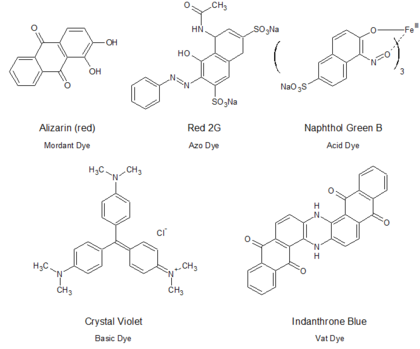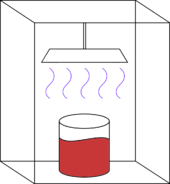
Industrial dye degradation is any of a number of processed by which dyes are broken down, ideally into innocuous products. Many dyes, specifically in the textile industry such as methylene blue or methyl red, are released into ecosystems through water waste. Many of these dyes can be carcinogenic. In paper recycling dyes can be removed from fibres during a deinking stage prior to degradation.
Methods

Heterogeneous photocataylsis is one approach to the degradation of dyes.
As applied to dye-containing effluents from the textile industry, several approaches are standardized for removal or degradation of dyes. These include oxidation, e.g. using air or hydrogen peroxide, ozone, or Fenton chemistry. One challenge is that oxidants can be indiscriminent such that large amounts of reagents can be required (see Chemical oxygen demand). One promising approach combines oxidation with photocatalysis. Reduction is also employed, a standard reagent being dithionite, which traditionally affords leuco dyes. Precipitation, often coupled with flocculation, is yet another approach, although it can produce substantial quantities of solids.
References
- Rauf, M.A.; Ashraf, S. Salman (2009). "Fundamental principles and application of heterogeneous photocatalytic degradation of dyes in solution". Chemical Engineering Journal. 151 (1–3): 10–18. doi:10.1016/j.cej.2009.02.026.
- Huang, C.; Y. Huang; H. Cheng; Y. Huang. Kinetic Study of an Immobilized Iron Oxide for Catalytic Degradation of Azo Dye Reactive Black B with Catalytic Decomposition of Hydrogen Peroxide. Catalysis Communications 2009, 10 (5), 561-566.
- Pandit, V.K.; Arbuj, S.S.; Pandit, Y.B.; Naik, S.D.; Rane, S.B.; Mulik, U.P.; Gosavic, S.W.; Kale, B.B. Solar Light driven Dye Degradation using novel Organo–Inorganic (6,13-Pentacenequinone/TiO2) Nanocomposite”. RSC Adv. 2015, 5, 10326-10331.
- Sewekow, Ulrich (2016). "Textile Dyeing, 7. Legal Aspects, Toxicology, and Ecology". Ullmann's Encyclopedia of Industrial Chemistry. pp. 1–11. doi:10.1002/14356007.u26_u06. ISBN 9783527306732.
- Shafiq, Iqrash; Hussain, Murid; Shehzad, Nasir; Maafa, Ibrahim M.; Akhter, Parveen; Amjad, Um-e-salma; Shafique, Sumeer; Razzaq, Abdul; Yang, Wenshu; Tahir, Muhammad; Russo, Nunzio (August 2019). "The effect of crystal facets and induced porosity on the performance of monoclinic BiVO4 for the enhanced visible-light driven photocatalytic abatement of methylene blue". Journal of Environmental Chemical Engineering. 7 (4): 103265. doi:10.1016/j.jece.2019.103265. ISSN 2213-3437. S2CID 198742844.